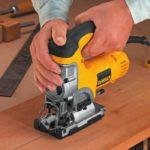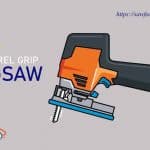For a woodworker or a carpenter, knowing about a best Jigsaw (Corded or Cordless) is never enough. Well, they are essential, but we often ignore the most fundamental topics. That will not happen today. We will talk about the principal of a jigsaw blade.
Your cutting performance and perfection depend on the jigsaw blade. Your money will be a total waste if you are not able to pick the right module. Six Principal Of A Jigsaw Blades! That’s what we will present with an infographic.
Let's move!
What's make a blade great?
Consider; First - blade-shank, T-shank, and U-shank are there in the market. After that, it uses the materials to make, the blade and teeth per inch or TPI.
The number of teeth a cutting edge has will influence both the speed and nature of the cut it can create. However, you need to pick the blade based on the materials you are going to cut such as wood, ceramics, etc.
What is the six principal of a Jigsaw blades?
How much your cutting task will be perfect; it will depend on the ideal match blades. However, it’s not an easy job for a newbie.
And considering this matter, we have brought together these six principals of a jigsaw blades- by analyzing the information of experienced users and manufacturers.
Hopefully, this will help you pick the right one.
- The shank type to the Blade
- Blade Material
- Teeth per inch (TPI)
- Tooth direction
- Blade's length
- Flush Cutting Blades
We have including a great infographic in this article that will let you know about any cutting situation. Our designers wanted to make sure that you get a visual image of saw blades that will be perfect for your job.
So let's go..
What is the Shank of a Jigsaw blades?
It’s worth remembering that every jigsaw blade will not fit every jigsaw clamp!
We classified the blades according to their shanks, and these shanks are only compatible with particular types of jigsaws. Some models are consistent with multiple shank types. However, most of the standard ones only accept a particular one.
Checking the manual of your jigsaw will help you to understand the shank type. You should select the shank for your jigsaw based on your choice, Jigsaw-shank types are separated into three major types. They are-
- T shank (tang shank)
- U shank (universal shank)
- U shank jigsaw blades with hole
Let’s know each of these types in detail.
What is T- Shank Jigsaw blades?
Most manufacturers are now using T-shank blades as a standard, which makes it easier to switchblades between different machines. T-shank jigsaw blades come with a tang at the top of their shank that fits into the blade clamp of the jigsaw.
Replacing the T-shank blade doesn’t need more than a simple push of a jigsaw button. It offers you a quick and easy way to replace the blades with no hassle.
Many of the U-shank jigsaws are also compatible with T-shank blades. These blades are compatible with most of the modern jigsaws available in the markets nowadays.
Users may get more benefits as suitable in using time and save time.
What is U-shank Jigsaw blades?
The U-shaped characterizes U-shank the edges cut out at the top of their shank. This older jigsaw machines must have a hole in the shank just below the U-shaped cut-out.
The U-shank Jigsaw blades are the oldest one. The type of blades requires extra tools to change blades. As a result, more time is wasted on your work , and the user gets irritated.
Although the T-shank has become more popular these days, the U-shank blades are still available.
What is U-shank jigsaw blades with hole?
The U shank jigsaw blades with hole are also the oldest type of jigsaw blades. Despite the popularity of T-Shank blades, these types of blades are still available in the market. These are used for certain tasks.

Share this Image On Your Site
[separator type="space"]
Blade Material: What Jigsaw blades are made of ?
All the Jigsaw overalls used (Corded or cordless jigsaw) have the same type of blades. Among the four fundamental types of blade materials, select the right one according to your cutting materials (task):
- High-speed steel (HSS)
- High carbon steel (HCS)
- Bi-metal
- Tungsten carbide
High-speed steel (HSS)
From the name, you may guess the efficient cutting of these blades. Though these blades will give you a smart finishing, the blades are prone to damage from the heat.
High carbon steel (HCS)
High carbon steel blades are more durable they are made with HCS since carbon is the hardest element. The amazing part of using the HSC blade is its flexible nature. Because of the strength and harness nature of HCS, they are perfect for edge retention.
HSC blades are inexpensive, allowing you to buy in bulk for your household or other DIY purposes. However, HSC blades are also less durable than HSS. Because of the absence of chromium, the jigsaw made with HSC has poor rust resistance ability.
Bi-metal
From the name bi-metal, you may guess that two types of metals are used in this jigsaw blade. Yes, you are right. Both carbon steel and high-speed steel teeth are used to develop the blade, allowing you to enjoy the advantages of both types of metal blades.
You can use a bi-metal jigsaw blade for hard woodcutting and metals. Most importantly, bi-metal blades have to wear resistance and are flexible in nature.
Tungsten carbide
These blades are the most durable among all in the market. These types of jigsaw are coated with tungsten carbide grit instead of teethes that are commonly used in other types of blades. Manufacturers are developing these types of jigsaw to use for ceramics, steel, or fiberglass.
What is teeth per inch (TPI) of Jigsaw blades?
You need to know a few basic facts before selecting the proper blade. What type of material do you plan to cut? Is it wood, metal, plastic, laminate, ceramic, or fiberglass? What type of cuts will you be making tight cuts, rough cuts, or a combination?
The number of teeth a cutting edge has will influence both the speed and nature of the cut it can produce. Sharp edges with fewer teeth will deliver a quicker, rougher cut, while those with more teeth cut the more gradually but make a smoother finish.
One of the most important things to consider is the number of blade teeth per inch. Most woodcutting blades have 12 teeth per inch, while metal-cutting blades may have up to 36. Generally, the fewer the teeth, the faster the blade will cut. However, blades with fewer teeth also mean a rougher cut.
For your conscience, TPI or teeth per inch is essential for an extreme performance, which is the number of “teeth” of your blades. The higher TPI offers higher perfection and smooth cut.
- TPI of between 6 and 20
- TPI of between 14 and 36.
What is the tooth direction of blades?
Blade direction is one of the most important for Perfect Cutting. Most of the jigsaw blades designed to cut on the upstroke and have teeth that point towards the shank; however, you can likewise purchase a jigsaw blade with a reverse shape.
It’s called down-cut or reverses tooth blades. We need the reverses tooth blade to cut some different materials or some exclusive designs.
What is Blade's length?
Always Choose the correct length for the material being cut. Never try to make a partial depth cut with a jigsaw. It may damage the blade or your saw, if the blade that is too short to entirely cut the workpiece. It is essential to use a saw blade that is long enough, excluding the cutting surfers' thickness.
Length of a best jigsaw blades cutting edge is showed by the length of the body that has teeth however, It excludes the upper shank that fits inside the sharp edge holder — the example below shows a 75 mm cutting edge.
The proper length of the sharp edge is 54 mm (2⅛”), which is 75 mm short of the 19 mm that does not stretch out beneath the saw’s sole plate.
Also, don’t forget to check out our reviews and buying guide about Best metal cutting jigsaw blades reviews
What is Flush cutting blades?
The Flush cutting feature has been introduced to very few jigsaws, it allows you to slice up a vertical surface.
It is fundamental to note a few of jigsaws, that have shoes are closed at the front, and can’t be used with this edge. If you are expecting flush cutting with a sharp master edge, ensure that your jigsaw allows a flush cutting edge.
The Last paragraph
Hopefully, you got enough information about the jigsaw blade. If it still confuses you, don’t worry. Read the article again and follow the infographic that will show your technical issue and features about jig-saw blades.
This infographic also helps you to think through each feature and how they match your necessities.






Awesome! No words. You always go one step beyond.
There is so much great, useful information here. Thank you! Thank you! Thank you!
Read our guide if you wish.
sawfinder
Thanks again 🙂
My husband likes doing masonry and woodwork for our home. So I’m planning to give him some good quality tools for his birthday such as cutting blades and more. it’s interesting to know that jigsaw blades of tungsten carbide are the most durable type in the market today and they are used mostly to cut steel and fiberglass.